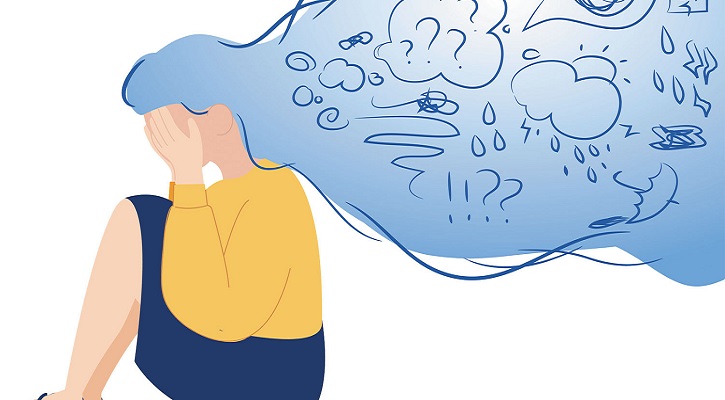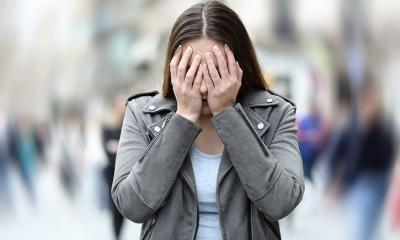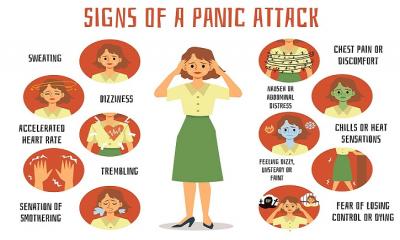
Types of Anxiety Disorders
- Women`s Corner
- October 2, 2022
Generalized Anxiety Disorder: Generalized anxiety disorder involves persistent and excessive worry that interferes with daily activities. This ongoing worry and tension may be accompanied by physical symptoms, such as restlessness, feeling on edge or easily fatigued, difficulty concentrating, muscle tension or problems sleeping. Often the worries focus on everyday things such as job responsibilities, family health or minor matters such as chores, car repairs, or appointments.
Panic Disorder: The core symptom of panic disorder is recurrent panic attacks, an overwhelming combination of physical and psychological distress. During an attack several of these symptoms occur in combination:
- Palpitations, pounding heart or rapid heart rate
- Sweating
- Trembling or shaking
- Feeling of shortness of breath or smothering sensations
- Chest pain
- Feeling dizzy, light-headed or faint
- Feeling of choking
- Numbness or tingling
- Chills or hot flashes
- Nausea or abdominal pains
- Feeling detached
- Fear of losing control
- Fear of dying
Read More: Some Important Ways to Show Love to Yourself
Because the symptoms are so severe, many people who experience a panic attack may believe they are having a heart attack or other life-threatening illness. They may go to a hospital emergency department. Panic attacks may be expected, such as a response to a feared object, or unexpected, apparently occurring for no reason. The mean age for onset of panic disorder is 20-24. Panic attacks may occur with other mental disorders such as depression or PTSD.
Phobias, Specific Phobia: A specific phobia is excessive and persistent fear of a specific object, situation or activity that is generally not harmful. Patients know their fear is excessive, but they can't overcome it. These fears cause such distress that some people go to extreme lengths to avoid what they fear. Examples are public speaking, fear of flying or fear of spiders.
Agoraphobia: Agoraphobia is the fear of being in situations where escape may be difficult or embarrassing, or help might not be available in the event of panic symptoms. The fear is out of proportion to the actual situation and lasts generally six months or more and causes problems in functioning. A person with agoraphobia experiences this fear in two or more of the following situations:
- Using public transportation
- Being in open spaces
- Being in enclosed places
- Standing in line or being in a crowd
- Being outside the home alone
Read More: What is Major Depressive Disorder?
The individual actively avoids the situation, requires a companion or endures with intense fear or anxiety. Untreated agoraphobia can become so serious that a person may be unable to leave the house. A person can only be diagnosed with agoraphobia if the fear is intensely upsetting, or if it significantly interferes with normal daily activities.
Social Anxiety Disorder (previously called social phobia): A person with social anxiety disorder has significant anxiety and discomfort about being embarrassed, humiliated, rejected or looked down on in social interactions. People with this disorder will try to avoid the situation or endure it with great anxiety. Common examples are extreme fear of public speaking, meeting new people or eating/drinking in public. The fear or anxiety causes problems with daily functioning and lasts at least six months.
Separation Anxiety Disorder: A person with separation anxiety disorder is excessively fearful or anxious about separation from those with whom he or she is attached. The feeling is beyond what is appropriate for the person's age, persists (at least four weeks in children and six months in adults) and causes problems functioning. A person with separation anxiety disorder may be persistently worried about losing the person closest to him or her, may be reluctant or refuse to go out or sleep away from home or without that person, or may experience nightmares about separation. Physical symptoms of distress often develop in childhood, but symptoms can carry though adulthood.
Risk Factors: The causes of anxiety disorders are currently unknown but likely involve a combination of factors including genetic, environmental, psychological and developmental. Anxiety disorders can run in families, suggesting that a combination of genes and environmental stresses can produce the disorders.
Read More: Easy Habits That Can Improve Mental Health
Diagnosis and Treatment: The first step is to see your doctor to make sure there is no physical problem causing the symptoms. If an anxiety disorder is diagnosed, a mental health professional can work with you on finding the best treatment. Unfortunately, many people with anxiety disorders don't seek help. They don't realize that they have an illness for which there are effective treatments.
Although each anxiety disorder has unique characteristics, most respond well to two types of treatment: psychotherapy or "talk therapy," and medications. These treatments can be given alone or in combination. Cognitive behavior therapy (CBT), a type of talk therapy, can help a person learn a different way of thinking, reacting and behaving to help feel less anxious. Medications will not cure anxiety disorders, but can provide significant relief from symptoms. The most commonly used medications are anti-anxiety medications (generally prescribed only for a short period of time) and antidepressants. Beta-blockers, used for heart conditions, are sometimes used to control physical symptoms of anxiety.
Self-Help, Coping, and Managing: There are a number of things people do to help cope with symptoms of anxiety disorders and make treatment more effective. Stress management techniques and meditation can be helpful. Support groups (in-person or online) can provide an opportunity to share experiences and coping strategies. Learning more about the specifics of a disorder and helping family and friends to understand the condition better can also be helpful. Avoid caffeine, which can worsen symptoms, and check with your doctor about any medications.
Read More: How to Cope With Anxiety and Depression?
Selective Mutism: Children with selective mutism do not speak in some social situations where they are expected to speak, such as school, even though they speak in other situations. They will speak in their home around immediate family members, but often will not speak even in front of others, such as close friends or grandparents.
The lack of speech may interfere with social communication, although children with this disorder sometimes use non-spoken or nonverbal means (e.g., grunting, pointing, writing). The lack of speech can also have significant consequences in school, leading to academic problems and social isolation. Many children with selective mutism also experience excessive shyness, fear of social embarrassment and high social anxiety. However, they typically have normal language skills.
Selective mutism usually begins before age 5, but it may not be formally identified until the child enters school. Many children will outgrow selective mutism. For children who also have social anxiety disorder, selective mutism may disappear, but symptoms of social anxiety disorder may remain.
This article is taken from https://psychiatry.org/








